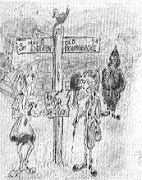Quiz question: Which Shakespeare sonnet has 15 lines? We’d better make it a tie-breaker. Nearest one to it.
Answer: Number 99.
The froward violet thus did I chide:
Sweet thief, whence didst thou steal thy sweet that smells,
If not from my love’s breath? The purple pride
Which on thy soft cheek for complexion dwells
In my love’s veins thou hast too grossly dyed.
The lily I condemnèd for thy hand,
And buds of marjoram had stol’n thy hair;
And roses fearfully in thorns did stand,
One blushing shame, another white despair;
A third, nor red nor white, had stol’n of both
And to his robb’ry had annex’d thy breath;
But, for his theft, in pride of all his growth
A vengeful canker eat him up to death.
More flowers I noted, yet I none could see
But sweet or colour it had stol’n from thee.
As you’d expect literary critics spend time arguing about whether it was just a draft that Shakespeare would have ‘corrected’ if he’d got round to it. As far as I’m concerned it’s a finished poem and if Shakespeare wanted to add a line, why not? He was Shakespeare. In fact, the sonnet proper begins at line 2, line 1 being a mere introduction or title.
The poem is a conventional comparison of the loved one’s beauty to that of flowers. The original conceit, if original it be, is that the flowers have themselves stolen the attractive qualities of the loved one.
Thus the violet has stolen the sweet smell of the lover’s breath (that must have been a rare quality in Shakespeare’s time), and its complexion pilfered from her/his own blood; the lily has purloined the white hands, and marjoram the hair (it might help if I knew what marjoram looked like). Roses are burdened with guilt for their crime; one has even been condemned to death for it.
I don’t think it’s one Will’s best. It’s a bit contrived and repetitive, and it’s basically a rewrite of Henry Constable’s sonnet, 'My Lady’s Presence'. You can read that one here:
Answer: Number 99.
The froward violet thus did I chide:
Sweet thief, whence didst thou steal thy sweet that smells,
If not from my love’s breath? The purple pride
Which on thy soft cheek for complexion dwells
In my love’s veins thou hast too grossly dyed.
The lily I condemnèd for thy hand,
And buds of marjoram had stol’n thy hair;
And roses fearfully in thorns did stand,
One blushing shame, another white despair;
A third, nor red nor white, had stol’n of both
And to his robb’ry had annex’d thy breath;
But, for his theft, in pride of all his growth
A vengeful canker eat him up to death.
More flowers I noted, yet I none could see
But sweet or colour it had stol’n from thee.
As you’d expect literary critics spend time arguing about whether it was just a draft that Shakespeare would have ‘corrected’ if he’d got round to it. As far as I’m concerned it’s a finished poem and if Shakespeare wanted to add a line, why not? He was Shakespeare. In fact, the sonnet proper begins at line 2, line 1 being a mere introduction or title.
The poem is a conventional comparison of the loved one’s beauty to that of flowers. The original conceit, if original it be, is that the flowers have themselves stolen the attractive qualities of the loved one.
Thus the violet has stolen the sweet smell of the lover’s breath (that must have been a rare quality in Shakespeare’s time), and its complexion pilfered from her/his own blood; the lily has purloined the white hands, and marjoram the hair (it might help if I knew what marjoram looked like). Roses are burdened with guilt for their crime; one has even been condemned to death for it.
I don’t think it’s one Will’s best. It’s a bit contrived and repetitive, and it’s basically a rewrite of Henry Constable’s sonnet, 'My Lady’s Presence'. You can read that one here:
http://www.dindragoste.ro/love/my-ladys-presence-makes-roses-red.php
For a more detailed analysis of Shakespeare's technique, try this:

No comments:
Post a Comment